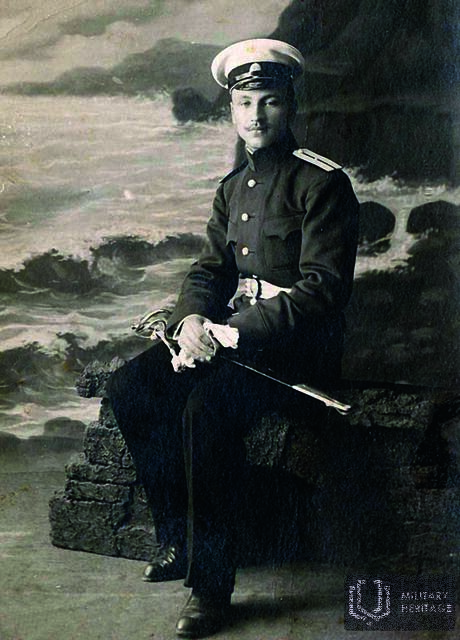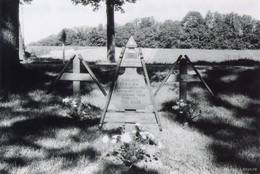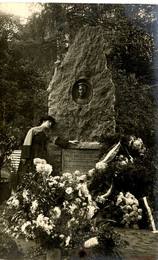Vilis Gelbe (arī Ģelbe, 1890-1919), jūras virsleitnants
I WW1, I Neatkarības kari
Vilis Gelbe dzimis 1890. gada 8. novembrī Zemītē. Beidzis vietējo skolu, Talsu pilsētas skolu, tad Engures un Pēterpils jūrskolas. Ieguvis tālbraucēja stūrmaņa diplomu un pēc Oranienbaumas jūrskolas beigšanas 1918. gada jūlijā arī kapteiņa diplomu. Pirmā pasaules kara laikā bijis kuģu «Kotka» un «Arguņ» komandieris, piedaloties operācijās pret vāciešiem.
1918. gada beigās viņš ieradās Latvijā un iestājās Latvijas bruņotajos spēkos. 1919. gada sākumā Vilis Gelbe darbojās no lieliniekiem atbrīvotajā Ziemeļlatvijā, kur viņam nācās uzņemties Valmieras apriņķa komandanta pienākumus. Viņš bija viens no tiem, kurš praktiski darbojās Ziemeļlatvijas brigādes izveidē, kas pēc līguma ar Igauniju tika veidota igauņu armijas pakļautībā. 1919. gadā maija beigās Vilis Gelbe tika komandēts uz Limbažiem, kurus bez kaujas bija jau ieņēmuši igauņu karavīri, jo komunisti bija aizbēguši uz Valmieru. Viņš bija pirmais Limbažu un apkārtnes kara komandants. Sākās pirmo militāro vienību veidošana no limbažniekiem, arī vecāko klašu skolniekiem. Komandantam Vilim Gelbem Limbažos un apkārtnē nācās darboties ļoti sarežģītā laikā, kad notika gatavošanās karam ar vācu dzelzs divīziju un landesvēru plašā Vidzemes teritorijā, kas pazīstamas kā Cēsu kaujas. Nereti darbu apgrūtināja ikdienišķi konflikti vietējo iedzīvotāju un igauņu karavīru starpā.
Cēsu kauju laikā Vilis Gelbe un viņa komandantūras vīri piedalījās cīņās ar vācu dzelzsdivīzijas karavīriem. 1919. gada 19. jūnijā pie Vidrižu muižas Gelbe ar komandu devās uzbrukumā vācu pārspēkam, ar savu drošsirdību pamudināja kareivjus cīņai, tā nodrošinot mūsu spēku labo spārnu. Šīs kaujas laikā viņš krita varoņa nāvē un pēc nāves 1921. gadā apbalvots ar Lāčplēša Kara ordeņa III šķiru. Vilis Gelbe apglabāts Limbažu kapos.
Viļa Gelbes kapa pieminekli 1922. gada 10. septembrī atklāja toreizējais Latvijas Valsts prezidents Jānis Čakste. Uzstādīta piemiņas zīme arī Viļa Gelbes pēdējās kaujas vietā Vidrižu muižas parkā.
Papildus izziņas avoti
Jānis Ulmis "Par tēvzemi mīļo…: Lāčplēša kara ordeņa kavalieris jūras virsleitnants Vilis Gelbe Ziemeļlatvijas bruņoto spēku izveidē un Latvijas Atbrīvošanas kara Cēsu kaujās". Limbaži: Limbažu muzejs, 2018.
Jānis Ulmis. Lāčplēša kara ordeņa kavalieris jūras virsleitnants Vilis Gelbe Ziemeļlatvijas bruņoto spēku izveidē un Latvijas Atbrīvošanas kara Cēsu kaujās. (Grāmatas fragmenti): https://limbazi.lv/novads/vesture/cesu-kaujas/6841-lacplesa-kara-ordena-kavaliera-juras-virsleitnantavila-gelbes-loma-ziemellatvijas-brunoto-speku-izveide-un-latvijas-atbrivosanas-kara-cesu-kaujas-landesvera-kara
Lāčplēša Kara ordeņa kavaliera Viļa Gelbes biogrāfija: http://lkok.com/detail1.asp?ID=533
Saistītās laikalīnijas
Saistītie objekti
Vidrižos piemiņas zīme vietā, kur kritis LKOK Vilis Gelbe un divi viņa komandas karavīri
Vidrižos pie pagrieziena uz Lēdurgu, Brīvības cīņu laikā 1919.gada 19.jūnijā, kaujā krita jūras virsleitnants Vilis Gelbe un divi karavīri.
Vilis Gelbe apglabāts Limbažu kapos. Par varoņdarbu pie Vidrižu muižas Vilis Gelbe apbalvots ar Lāčplēša Kara ordeņa III šķiru (Nr. 895).
Šobrīd kaujas vietā apskatāmi trīs pemiņas krusti, kas uzstādīti 1989.gadā.
1934. gada 22. jūnijā pie muižas parkā augošās kļavas tika atklāta pēc mākslinieka Stefana Berca meta darināta bronzas piemiņas plāksne. Jau komunistiskās okupācijas sākumā 1940. gada rudenī piemiņas plāksne pazuda. Arī kļava, pie kuras tā bija pienaglota, gājusi bojā. Sākoties Atmodai, 1989. gada 19. jūnijā, Gelbes un divu viņa komandas karavīru – kaprāļa Krustiņa un kareivja Krūzes – nāves 70. gadskārtā, ceļu krustojumā, kur kādreiz atradās piemiņas plāksne, pēc Vides aizsardzības kluba un Latvijas Tautas frontes Limbažu novada nodaļu iniciatīvas, uzstādīja trīs Jāņa Eglīša tautiskā stilā darinātus koka krustus. Ar Limbažu rajona izpildkomitejas lēmumu 1991. gada aprīlī šī piemiņas vieta iekļauta vietējās nozīmes vēstures pieminekļu sarakstā.
Piemineklis jūras virsleitnantam, L.k.o.k. Vilim Ģelbem (1890-1919)
Atrodas Limbažu Jūras ielas kapos, Jūras iela 56, Limbažos
Apskatāms 1922. gada 10. septembrī toreizējais Latvijas Valsts prezidents Jānis Čakste atklāts piemineklis, uz kura lasāms dzejnieka Viļa Plūdoņa veltījums Vilim Gelbem:
«Tautiet, kas garām man eji, iededzies tēvzemes mīlā,
par tēvzemi mīļo, es dzīvību atstāju ķīlā.»
Vilis Gelbe (1890-1919) dzimis Kurzemē, Zemītes pagastā, taču cieši saistīts arī ar Limbažu pusi, jo, sākoties Latvijas Neatkarības karam, no Pēterburgas atgriezās Latvijā un iestājās Ziemeļlatvijas brigādē.
1919. gada maijā V.Gelbi komandēja uz Limbažiem, viņš kļuva par apkārtnes kara komandantu un spēja iedvesmot šejienes vīrus un arī vēl pavisam jaunus puišus pievienoties armijai.
V. Gelbes toreizējā darbība Limbažos un to apkārtnē bija ļoti nozīmīga, viņa pienākumos ietilpst ne tikai kārtības uzturēšana pilsētā un apkārtnē, bet arī mobilizācija, pārtikas sagādāšana karavīriem un zirgiem un daudzu citu jautājumu risināšana, ko nevar ietvert pavēlēs un instrukcijās. Viņa organizētā komandantūras komanda darbojās kā saskaņots mehānisms, lai Ziemeļlatvijas brigādei sniegtu pēc iespējas efektīvāku palīdzību. Komandantūras komanda sevišķos gadījumos devās palīgā regulārajai armijai, un viņš rādīja priekšzīmi jaunkareivjiem. V. Gelbe bija pirmais Latvijas armijas virsnieks, kurš savus padotos ierosināja apbalvot ar Imantas ordeņa III šķiru. Ordeņa gan vēl nebija. Imantas vārds atklātībā parādījās tikai 1920. gada 20. martā, kad apsardzības ministram Kārlim Ulmanim tika iesniegts izklāsts par kara ordeņa dibināšanu. Ordenim tomēr izvēlējās Lāčplēša vārdu.
Cēsu kauju laikā Vilis Gelbe gāja bojā - 1919. gada 19. jūnijā izlūkgājiena laikā. Vēlāk Gelbem piešķīra Lāčplēša Kara ordeni, tomēr vēsturnieki spriež - kopumā viņa devums līdz šim nav bijis pienācīgi novērtēts. Galvenokārt tas skaidrojams ar Gelbes piederību Ziemeļlatvijas brigādei.
Savā starpā konkurēja tā saucamā Dienvidlatvijas brigāde, kas bija sākotnēji Oskara Kaplaka, vēlāk Jāņa Baloža komandēta, ar Ziemeļlatvijas brigādi, kas bija Jorģa Zemitāna komandēta.
Piemineklis Latvijas Neatkarības karā kritušo karavīru piemiņai Limbažos
Atrodas līdzās Limbažu Sv. Jāņa luterāņu baznīcai, Lībiešu ielā 2.
Apskatāms piemiņas vieta Limbažu un apkaimes kritušajiem kareivjiem un virsleitnantam Vilim Gelbem (1890-1919), kurš 1919.gada 19.jūnijā Vidrižos krita kaujā pret vāciešiem.
Virsleitnants, L.k.o.k. Viļa Gelbes piemineklis apskatāms Limbažu Jūras ielas kapos.
Saistītie stāsti
Par nacionālo patriotu virsleitnantu Vili Gelbi
Virsleitnanta Viļa Gelbes (1890-1919) liktenis atspoguļo sarežģīto situāciju mūsu valsts un armijas tapšanā, kā arī šo notikumu novērtējumā.
Līdz ar Latvijas valsts proklamēšanu 1918. gada 18. novembrī sākās arī tās Neatkarības karš un bruņoto spēku veidošanas darbs. Brīvprātīgo latviešu karavīru pirmajās rindās bija Kurzemē dzimušais jūras virsleitnants Vilis Gelbe.
Cēsu kauju sākums, notikumu gaita un noslēgums
Gūtajai uzvarai Cēsu kaujās bija lemts kļūt par pagrieziena punktu latviešu un igauņu cīņā par savas valsts neatkarību. Šī uzvara pārvilka svītru Andrieva Niedras valdības un Vācijas ģenerāļa Rīdigera fon der Golca Baltijas iekarošanas plāniem. Tā vietā savu darbību Liepājā atjaunoja Kārļa Ulmaņa Latvijas Pagaidu valdība.









![Limbaži. Valsts prezidents J. Čakste atklāj pieminekli Limbažos I Pasaules karā kritušajiem. Latvijas Brīvības cīņu pieminekļa atklāšana [1923]. Avots: Latvijas Nacionālās bibliotēkas digitālais krājums "Zudusī Latvija".](/g/Poi/00403/44213.png?size=260)